Room Mantova Benavides 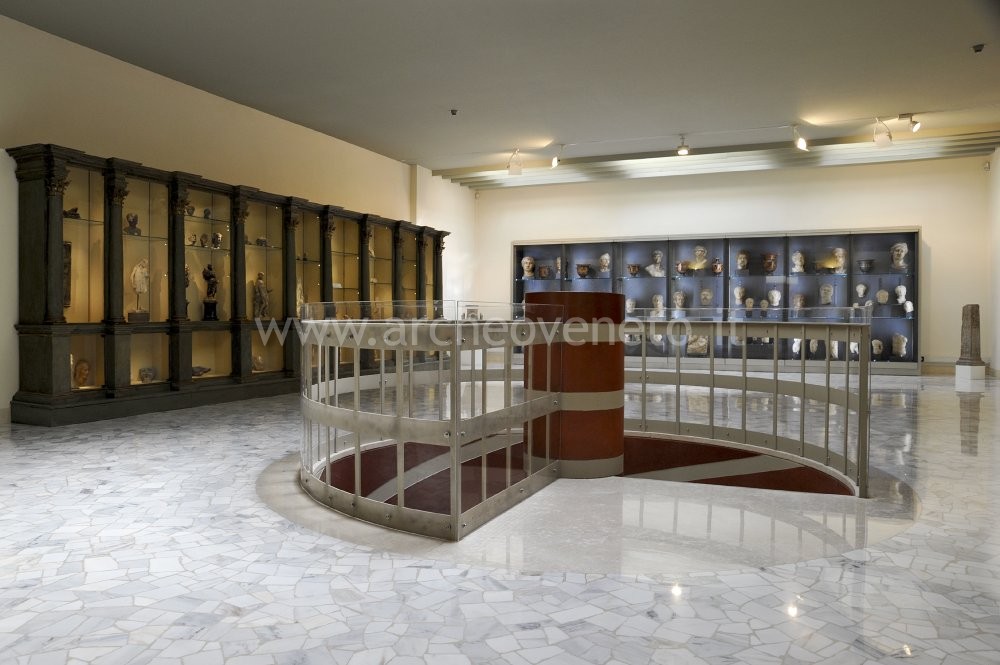 The large entrance hall is devoted to the collection of Marco Mantova Benavides, which was put together in the 16th century and donated to the University of Padua in 1733 thanks to the bequest of Antonio Vallisneri junior. The room contains ancient and Renaissance marble works and sculptures, fifteenth century and ancient vases, coins and medals, musical instruments and old-style portraits, of the Veneto school, which inspired some of the paintings that can be seen in the Giants Hall.
The visit to the museum is a travel back in time, starting from Renaissance sculptures and old-style works, which are placed on a valuable sixteenth century piece of furniture, and ending with the ancient sculptures, which are located along the eastern and southern walls of the room. The most interesting ancient artefacts include the Greek original votive statuette representing Athena of the 4th cent. B.C. and the Hellenistic copy of the marble sculpture representing Eros that loosens Lysippos’ bow. The large entrance hall is devoted to the collection of Marco Mantova Benavides, which was put together in the 16th century and donated to the University of Padua in 1733 thanks to the bequest of Antonio Vallisneri junior. The room contains ancient and Renaissance marble works and sculptures, fifteenth century and ancient vases, coins and medals, musical instruments and old-style portraits, of the Veneto school, which inspired some of the paintings that can be seen in the Giants Hall.
The visit to the museum is a travel back in time, starting from Renaissance sculptures and old-style works, which are placed on a valuable sixteenth century piece of furniture, and ending with the ancient sculptures, which are located along the eastern and southern walls of the room. The most interesting ancient artefacts include the Greek original votive statuette representing Athena of the 4th cent. B.C. and the Hellenistic copy of the marble sculpture representing Eros that loosens Lysippos’ bow. |
Room 1  Not accomplished yet. Not accomplished yet. |
Room 2 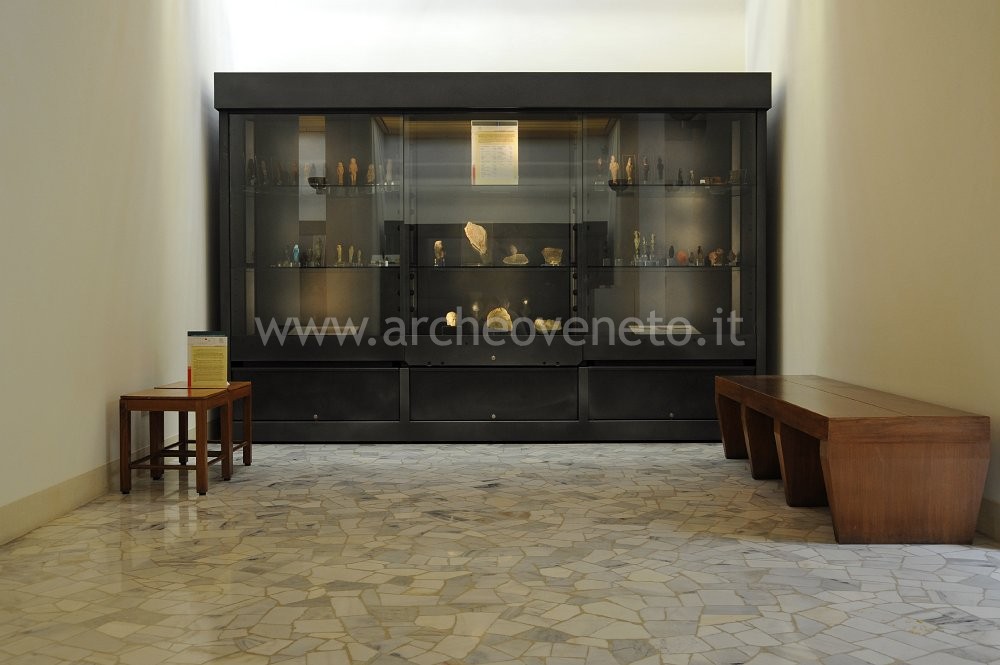 This room contains the objects belonging to the Egyptian culture, which are divided according to their origin. The large display case contains on the first two shelves the Neumann collection (earthenware and ushabtis), which was donated to the University in 1925, a depicted bas-relief, small bronzes and earthenware, whereas on the lower shelf it is possible to see the items discovered during the excavation carried out by Carlo Anti in the site of Tebtynis between 1930 and 1935. This room contains the objects belonging to the Egyptian culture, which are divided according to their origin. The large display case contains on the first two shelves the Neumann collection (earthenware and ushabtis), which was donated to the University in 1925, a depicted bas-relief, small bronzes and earthenware, whereas on the lower shelf it is possible to see the items discovered during the excavation carried out by Carlo Anti in the site of Tebtynis between 1930 and 1935. |
Room 3 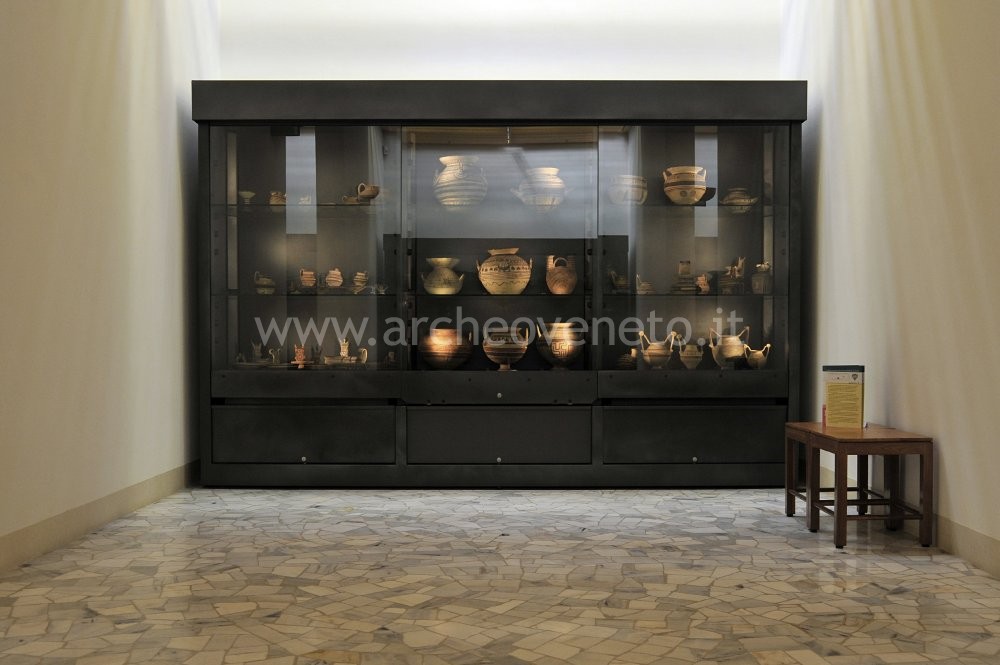 The room is devoted to the Apulian geometric vases (8th-4th cent. B.C.) coming from the collection of Mr. and Mrs. Merlin. The upper part of the display case contains Daunian ollas and vessels of large dimensions decorated with stylized geometric patterns and animal protomes. The lower shelf displays examples of Peucetian and Messapian pottery decorated with naturalistic phytomorphic motifs. The room is devoted to the Apulian geometric vases (8th-4th cent. B.C.) coming from the collection of Mr. and Mrs. Merlin. The upper part of the display case contains Daunian ollas and vessels of large dimensions decorated with stylized geometric patterns and animal protomes. The lower shelf displays examples of Peucetian and Messapian pottery decorated with naturalistic phytomorphic motifs. |
Room 4 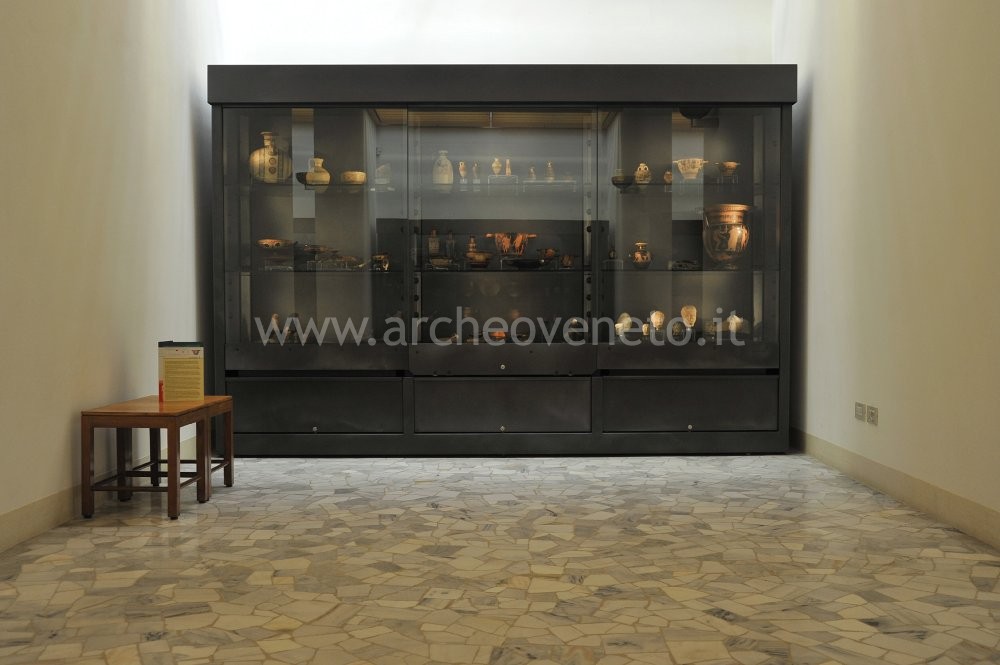 The display case in this room contains Greek items, coming from different donations, in particular from the one of the Merlin family. The objects are presented in a chronological order starting from the top; the first shelf displays Cypriot materials dating back to the Iron Age and some examples of Corinthian pottery (second quarter of the 8th cent. - early 6th cent. B.C.), whereas the central shelf contains numerous black and red figure pots from Attica that reproduce the most famous sculptures. Beside these examples of production of artistic objects made of clay, there are also tools used in everyday life and domestic activities. The display case in this room contains Greek items, coming from different donations, in particular from the one of the Merlin family. The objects are presented in a chronological order starting from the top; the first shelf displays Cypriot materials dating back to the Iron Age and some examples of Corinthian pottery (second quarter of the 8th cent. - early 6th cent. B.C.), whereas the central shelf contains numerous black and red figure pots from Attica that reproduce the most famous sculptures. Beside these examples of production of artistic objects made of clay, there are also tools used in everyday life and domestic activities. |
Room 5  This room contains Venetic materials, which are arranged according to a chronological criterion, that is from the most ancient (hand-shaped pottery, 8th-7th cent. B.C.) to the most recent ones (grey pottery, late 5th cent., Roman age). Next to the fictile materials, there is a plaster reproduction of the famous Benvenuti Situla, which can be seen in the National Museum of Este. The large display case contains also ornamental accessories, items of clothing and objects used in everyday life (fibulae, pins, spindle whorls, reels), as well as items coming from votive contexts (small votive pots and bronzes). This room contains Venetic materials, which are arranged according to a chronological criterion, that is from the most ancient (hand-shaped pottery, 8th-7th cent. B.C.) to the most recent ones (grey pottery, late 5th cent., Roman age). Next to the fictile materials, there is a plaster reproduction of the famous Benvenuti Situla, which can be seen in the National Museum of Este. The large display case contains also ornamental accessories, items of clothing and objects used in everyday life (fibulae, pins, spindle whorls, reels), as well as items coming from votive contexts (small votive pots and bronzes). |
Room 6 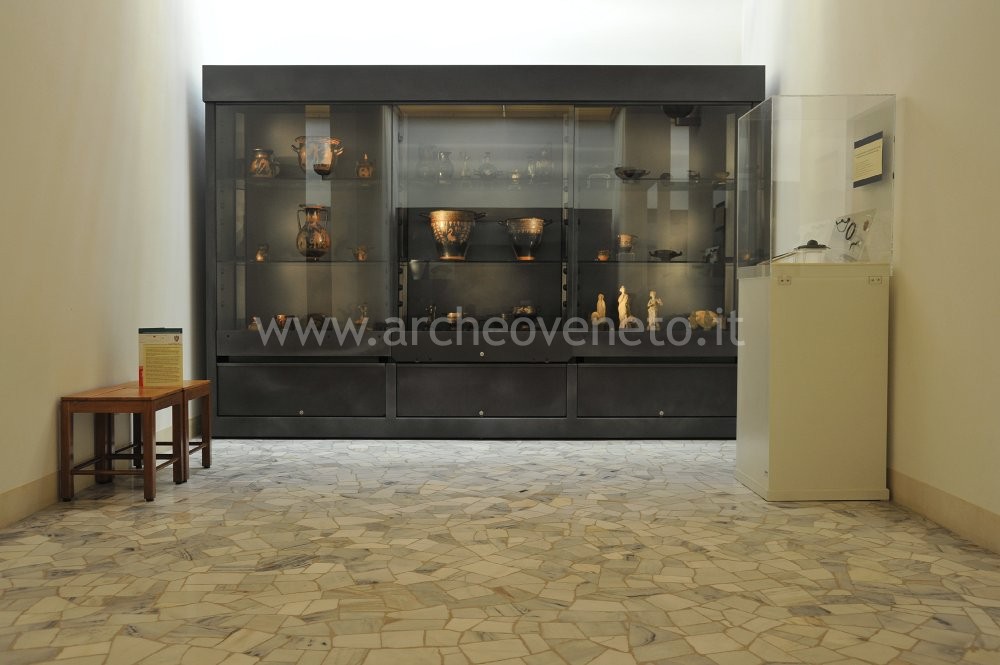 The room is devoted to the archaeological finds from Magna Graecia belonging to the Merlin collection. They are arranged vertically, to help the visitors better to identify the different types of pottery presented. The section on the left displays the Apulian and Campanian red figure pottery; the central one shows the production of pottery in the Gnathia style, while in the third sector it is possible to see some examples of black varnish and black-painted pottery. There are also some earthen artistic objects (statuettes and antefix) and two bronze coins from Metaponto. The room is devoted to the archaeological finds from Magna Graecia belonging to the Merlin collection. They are arranged vertically, to help the visitors better to identify the different types of pottery presented. The section on the left displays the Apulian and Campanian red figure pottery; the central one shows the production of pottery in the Gnathia style, while in the third sector it is possible to see some examples of black varnish and black-painted pottery. There are also some earthen artistic objects (statuettes and antefix) and two bronze coins from Metaponto. |
Room 7 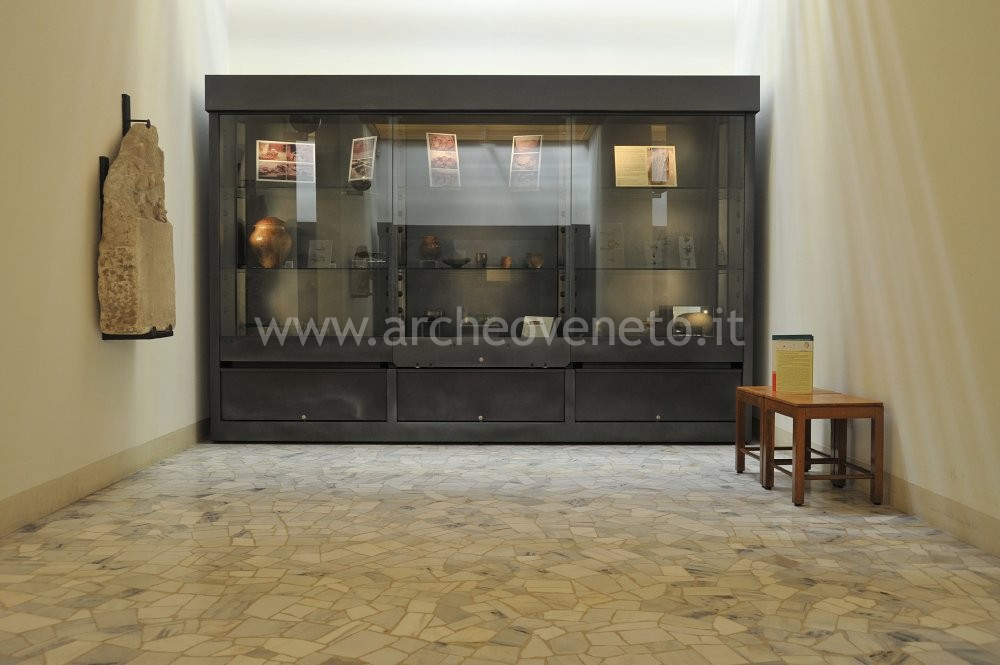 The display case in this room contains grave goods from the necropolis of Piovego, in the province of Padua that can be traced back to a time between the first quarter of the 6th cent. and the mid 4th cent. B.C., where more than 150 burials were discovered during the excavation carried out in the 70’s. The grave goods displayed include the dolium, the ossuary olla and all the ornamental accessories (glass beads, fibulae, pendants) and everyday objects (set of ceramic vases) that were laid in the burial. Next to them, it is possible to see materials of different origin, including a large knife case in bronze foil with frieze, an Attic skyphos and a large porphyry cobblestone with Venetic inscription. The display case in this room contains grave goods from the necropolis of Piovego, in the province of Padua that can be traced back to a time between the first quarter of the 6th cent. and the mid 4th cent. B.C., where more than 150 burials were discovered during the excavation carried out in the 70’s. The grave goods displayed include the dolium, the ossuary olla and all the ornamental accessories (glass beads, fibulae, pendants) and everyday objects (set of ceramic vases) that were laid in the burial. Next to them, it is possible to see materials of different origin, including a large knife case in bronze foil with frieze, an Attic skyphos and a large porphyry cobblestone with Venetic inscription. |
Room 8 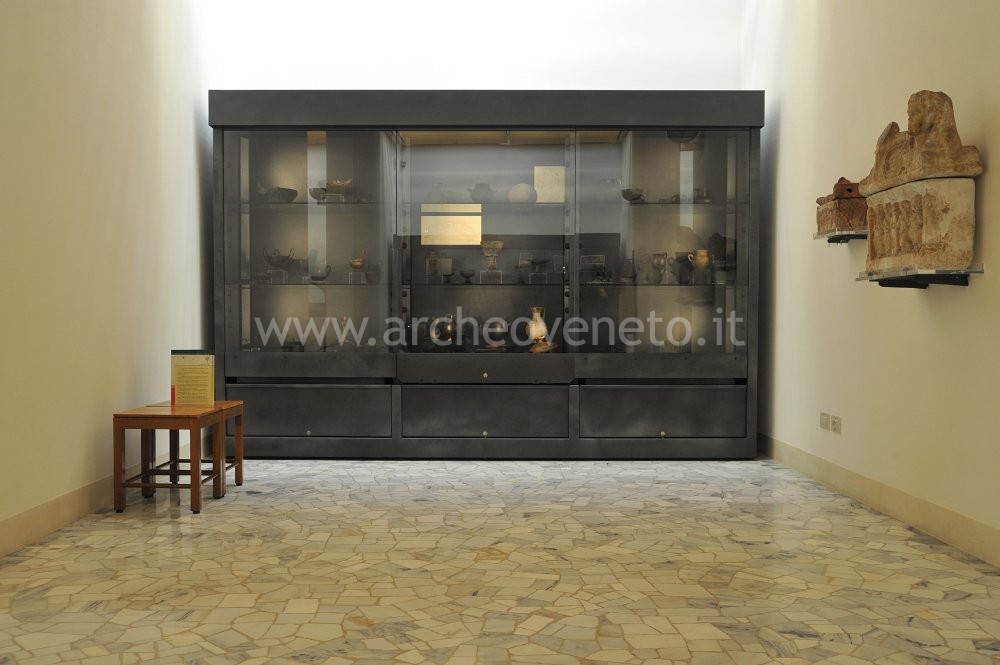 The items contained in this room belong to the Etruscan manufacturing tradition. Here it is possible to see some examples of Etruscan – Latial pottery (9th-7th cent. B.C.) of both thin- and thick-walled bucchero, a kind of black pottery, (second half of the 8th cent.-late 6th cent. B.C.) and of pottery coming from the Upper Adriatic area, which discovered during the excavation in the Greek-Etruscan necropolis of Spina. Next to these objects, it is possible to see some Etruscan bronzes, including two mirrors and two candlesticks. There are also two Etruscan decorated funerary urns. The items contained in this room belong to the Etruscan manufacturing tradition. Here it is possible to see some examples of Etruscan – Latial pottery (9th-7th cent. B.C.) of both thin- and thick-walled bucchero, a kind of black pottery, (second half of the 8th cent.-late 6th cent. B.C.) and of pottery coming from the Upper Adriatic area, which discovered during the excavation in the Greek-Etruscan necropolis of Spina. Next to these objects, it is possible to see some Etruscan bronzes, including two mirrors and two candlesticks. There are also two Etruscan decorated funerary urns. |
Room 9 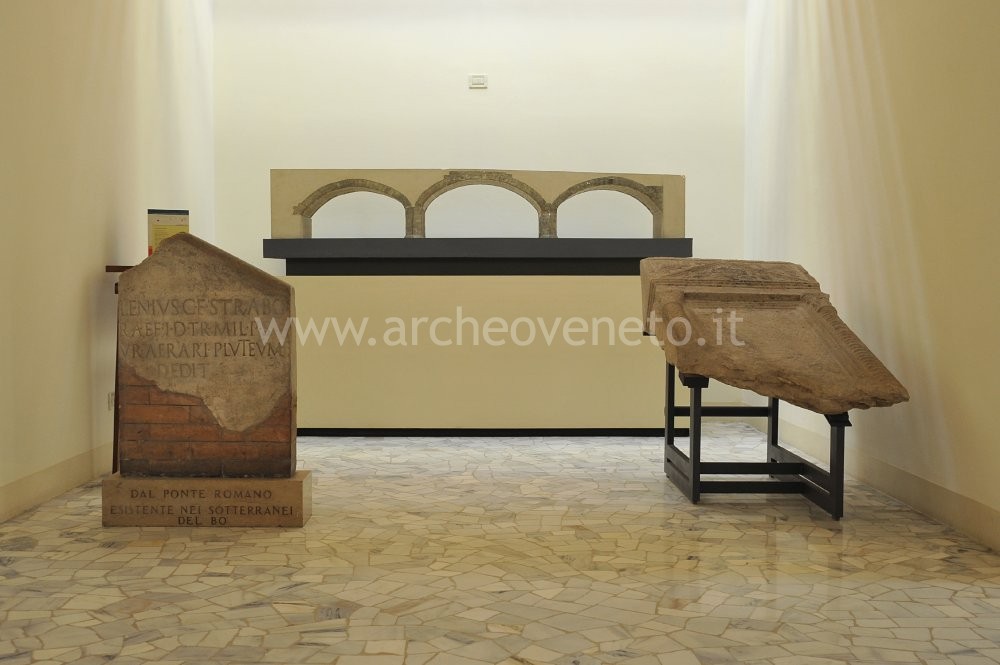 The room displays a reproduction on a 1:20 scale of the Roman bridge of San Lorenzo (40-30 B.C.), which connected the two banks of the Medoacus river in the area overlooking the river port. Near the model, there are two inscriptions, a funerary one and a dedicatory one probably from the rail of the bridge itself. The room displays a reproduction on a 1:20 scale of the Roman bridge of San Lorenzo (40-30 B.C.), which connected the two banks of the Medoacus river in the area overlooking the river port. Near the model, there are two inscriptions, a funerary one and a dedicatory one probably from the rail of the bridge itself. |
Room 10 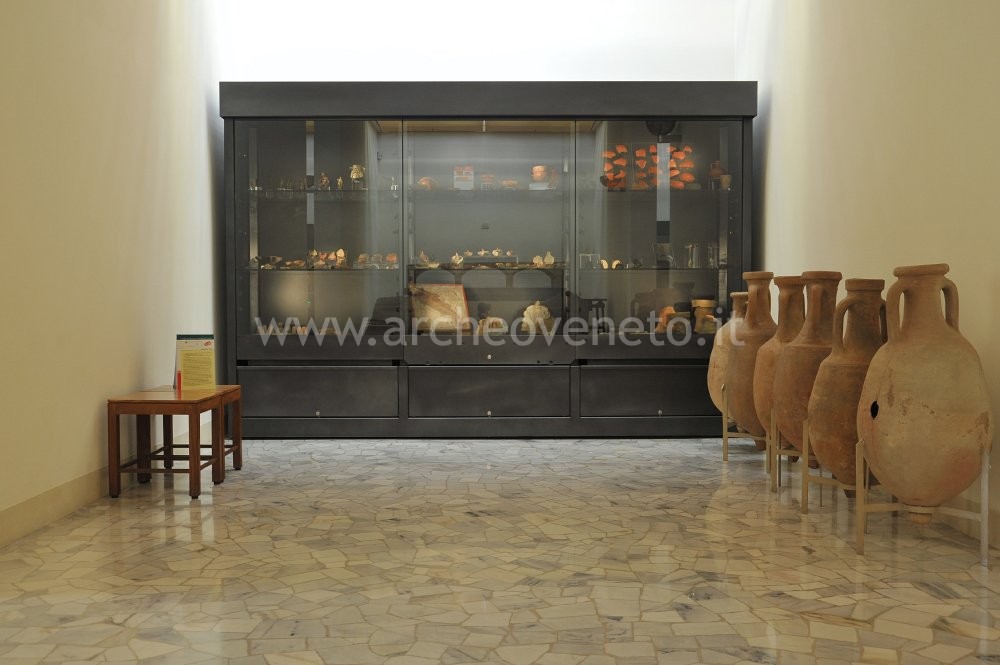 The room shows items belonging to the everyday life of the Romans, divided according to the field they refer to. The first section addresses the topic of culture and includes a large amount of small bronzes reproducing both Latin and eastern deities. The second section regards table pottery, in particular examples of Italic and Gallic sigillata. Here it is also possible to see some bronze objects, such as a set of kitchenware. The last section focuses on domestic and work activities (loom weights, sickles, spindle whorls) making also reference to the domus, thanks to the exhibition of a few antefixes and two portions of a fresco and a floor mosaic. The room shows items belonging to the everyday life of the Romans, divided according to the field they refer to. The first section addresses the topic of culture and includes a large amount of small bronzes reproducing both Latin and eastern deities. The second section regards table pottery, in particular examples of Italic and Gallic sigillata. Here it is also possible to see some bronze objects, such as a set of kitchenware. The last section focuses on domestic and work activities (loom weights, sickles, spindle whorls) making also reference to the domus, thanks to the exhibition of a few antefixes and two portions of a fresco and a floor mosaic. |
Room 11  Not used for exhibition purposes Not used for exhibition purposes |
Room 12 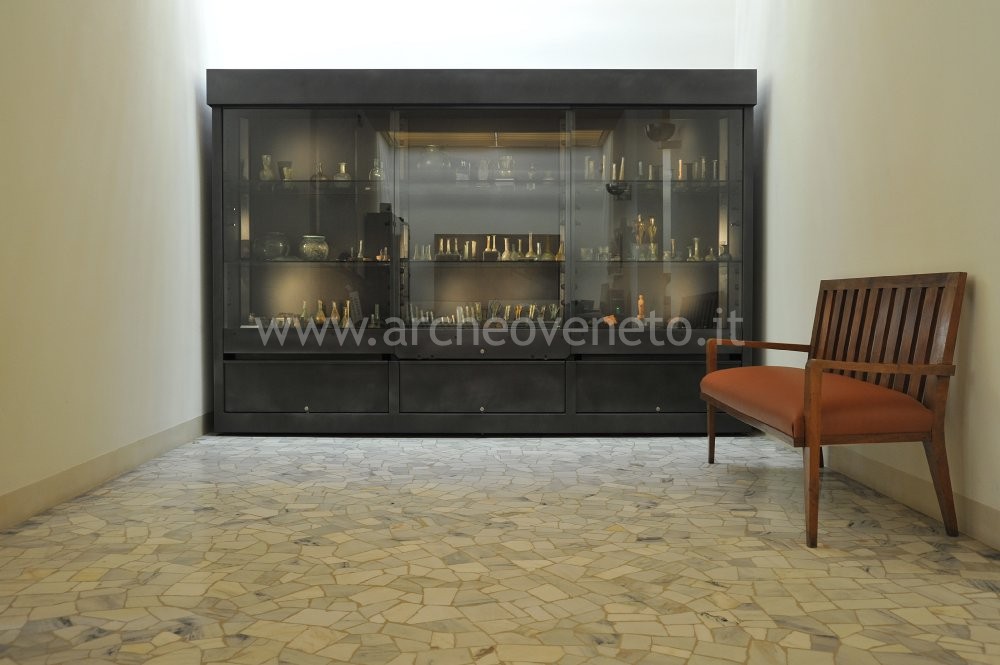 The last exhibition room contains finds referring to the manufacturing of glass objects in the roman and eastern (Syro-Palestinian and Cypriot) communities.
The first section of the display case contains a few bottles and closed vessels of eastern origin (2nd-4th cent. A.D.), as well as some unguentaria with long fluted neck and flat rim coming from different areas. The central shelf contains some globular ollas produced in northern Italy that make reference to the field of funerary practices. The last shelf displays the fakes that have been donated to the museum by private collectors, who have always been fascinated by what is (or just looks) ancient. The last exhibition room contains finds referring to the manufacturing of glass objects in the roman and eastern (Syro-Palestinian and Cypriot) communities.
The first section of the display case contains a few bottles and closed vessels of eastern origin (2nd-4th cent. A.D.), as well as some unguentaria with long fluted neck and flat rim coming from different areas. The central shelf contains some globular ollas produced in northern Italy that make reference to the field of funerary practices. The last shelf displays the fakes that have been donated to the museum by private collectors, who have always been fascinated by what is (or just looks) ancient. |
Collection of plaster casts  The collection of plaster casts displays today an expositive plan that complies with the original plan of the architect Gio Ponti, who had accomplished a very accurate study of the architectural space and of colours. The new expositive plan entails a division of statues in the round, busts, heads and reliefs in plaster according to the chronological order, the schools and the sculptors; to this end a chronological-didactic path was designed to explore the world of Greek and Roman sculpture. Once you enter this room, you see a collection of marble samples, recently donated to the museum by Professor Lazzarini; next to them it is possible to see a collection of plaster casts referring to the Minoan civilisation. The centre of the room is dominated by the impluvium and the most important plaster casts of the collection are located in its colonnade. Another reference to the classical architecture can be seen in the hemicycle, which often hosts the meetings that take place in the museum and which displays the impressive plaster cast of the Hermes of Praxiteles. The collection goes on with the exhibition of the plaster casts of works of the Parthenon (5th cent. B.C.), other Greek sculptures of the classic period (5th-4th cent. B.C.), hellenistic works of the Pergamon school (2nd cent. B.C.) and of the Roman age. The collection of plaster casts displays today an expositive plan that complies with the original plan of the architect Gio Ponti, who had accomplished a very accurate study of the architectural space and of colours. The new expositive plan entails a division of statues in the round, busts, heads and reliefs in plaster according to the chronological order, the schools and the sculptors; to this end a chronological-didactic path was designed to explore the world of Greek and Roman sculpture. Once you enter this room, you see a collection of marble samples, recently donated to the museum by Professor Lazzarini; next to them it is possible to see a collection of plaster casts referring to the Minoan civilisation. The centre of the room is dominated by the impluvium and the most important plaster casts of the collection are located in its colonnade. Another reference to the classical architecture can be seen in the hemicycle, which often hosts the meetings that take place in the museum and which displays the impressive plaster cast of the Hermes of Praxiteles. The collection goes on with the exhibition of the plaster casts of works of the Parthenon (5th cent. B.C.), other Greek sculptures of the classic period (5th-4th cent. B.C.), hellenistic works of the Pergamon school (2nd cent. B.C.) and of the Roman age. |
| Favaretto I. 1976, Il Museo del Liviano a Padova. Itinerario per il visitatore, Padova, pp. 49-60. |
| I Musei, le collezioni scientifiche e le sezioni antiche delle Biblioteche 1996, a cura di Gregolin C., Padova, pp. 49-60. |
| Menegazzi A. 2000, Dalla collezione Mantova Benavides al Museo Vallisnerano. Antichità e oggetti d’arte, in La curiosità e l’ingegno. Collezionismo scientifico e metodo sperimentale a Padova nel Settecento, Padova, pp. 117-129. |
| Guida ai beni storico-artistici della Provincia di Padova 2004, a cura di Marconato R., Padova, pp. 22. |
| Musei e raccolte archeologiche del Veneto 2004, a cura di Di Mauro A., Dosson di Casier, pp. 47-49. |
| Menegazzi A. 2006, La Gipsoteca del Museo di Scienze Archeologiche e d’Arte dell’Università di Padova: l’esposizione e la fruizione , in Gipsoteche. Realtà e storia, Atti del Convegno Internazionale (Possagno, 19-20 maggio 2006), a cura di Guderzo M., Possagno, pp. 17-27. |
| Menegazzi A. 2008, Le donazioni al Museo di Scienze Archeologiche e d’Arte dell’Università di Padova nel XXI secolo: una tradizione che si rinnova, in Il collezionismo privato nella fruizione pubblica. Quando il museo è presidio di tutela e promotore di valorizzazione, Atti della XXI Conferenza Regionale dei Musei del Veneto (Venezia, 29-30 novembre 2007), Venezia, pp. 114-119. |
| Bonetto J. 2009, Veneto (Archeologia delle Regioni d'Italia), Roma, pp. 397-398. |

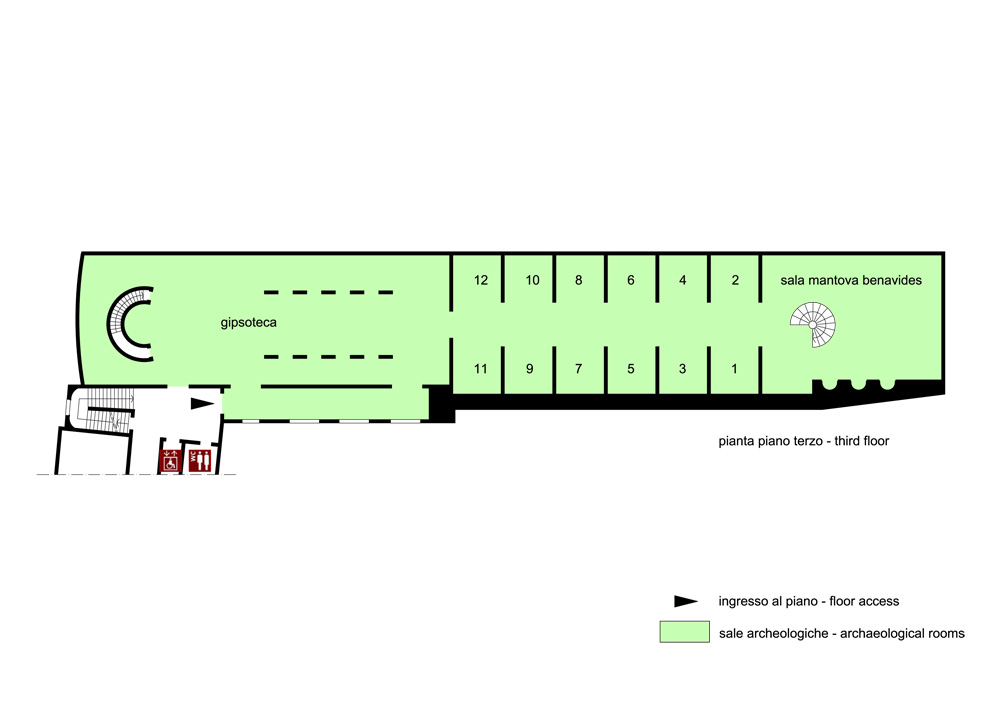
 School access
School access
 Disabled access
Disabled access
 Toilet
Toilet Catalogo
Catalogo Information boards
Information boards Mobile cards
Mobile cards Captions under exhibits
Captions under exhibits Multilingual ads: Inglese
Multilingual ads: Inglese Guided Tours
Guided Tours  Educational activities
Educational activities Library and documentation centre
Library and documentation centre Other activities
Other activities









